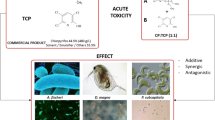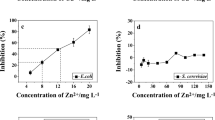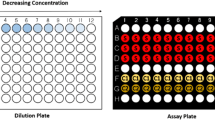Abstract
As a complement to previous results obtained using the standard Microtox acute-toxicity test, which is based on measuring the rapid decrease of bioluminescence (5 to 30 minutes of exposure) in Vibrio fischeri bacteria in the presence of toxicants, the long-term effects of Cd(II), Cr(VI), and As(V) were studied on growth rate and viability assays of the same bacteria adapted to longer-lasting cultures, i.e., 48 or 72 hours instead of 5 or 30 minutes. Effects on viability or growth, as studied by establishing dose- and time-response curves, confirmed that these poisonous chemicals were not particularly toxic to these bacteria. Nevertheless, in the case of Cr(VI), the viability-inhibition assay appeared to be more sensitive than the Microtox acute-toxicity test. Interestingly, it was possible to observe a clear hormesis phenomenon, especially for Cd(II), under the conditions of both viability- and growth-inhibition assays.




Similar content being viewed by others
References
Backhaus T, Froehner K, Altenburger R, Grimme LH (1997) Toxicity testing with Vibrio fischeri: A comparison between the long term (24h) and the short term (30 min) bioassay. Chemosphere 35:2925–2938
Bopp LH, Erhlich HL (1988) Chromate resistance and reduction in Pseudomonas fluorescens strain LB300. Arch Microbiol 150:426–431
Bulich A (1986) Bioluminescence assays. In: Bitton G, Dutka B (eds) Toxicity testing using microorganisms. Volume 1. CRC, Boca Raton, FL, pp 27–55
Calabrese EJ, (1999) Evidence that hormesis represents an overcompensation response to a disruption in homeostasis. Ecotoxicol Environ Saf 42:35–137
Campos J, Martinez-Pacheco M, Cervantes C (1995) Hexavalent chromium reduction by a chromate resistant Bacillus sp strain. Antonie van Leeuwenhoek 6:203–208
Chen BY, Liu HL, Chen YW, Cheng YC (2004) Dose-response assessment of metal toxicity upon indigenous Thiobacillus thiooxidans BC1. Process Biochem 39:735–745
Christofi N, Hoffmann C, Tosh L (2002) Hormesis responses of free and immobilized light emitting bacteria. Ecotoxicol Environ Saf 52:227–231
Delmas F, Villaescusa I, Woo NYS, Soleilhavoup JP, Murat JC (2000) A cellular method for the evaluation of the noxiousness of inorganic pollutants in industrial wastes: Calculation of a safety index for monitoring sludge discharge. Ecotoxicol Environ Saf 45:260–265
Desjardin V, Bayard R, Lejeune P, Gourdon R (2003) Utilization of supernatants of pure cultures of Streptomyces thermocarboxydus to reduce chromium toxicity and mobility in contaminated soils. Water Air Soil Pollut 3:153–160
Di Pietro A, Scoglio ME, Anzalone C, Calimeri S, LoGiudice D, Marino A (2000) Effect of metal mixtures on Salmonella enteritidis viability in synthetic sewage. Ann Ig 12:469–478
Fulladosa E, Murat JC, Martinez M, Villaescusa I (2004a) Effect of pH on arsenate and arsenite toxicity to luminescent bacteria (Vibrio fischeri). Arch Environ Contam Toxicol 46:176–183
Fulladosa E, Desjardin V, Villaescusa I, Gourdon R (2004b) Toxic effect and reduction of Cr(VI) in Vibrio fischeri bacteria. Environ Toxicol Chem (submitted)
Gaubin Y, Vaissade F, Croute F, Beau B, Soleilhavoup JP, Murat JC (2000) Implication of free radicals and glutathione in the mechanism of cadmium-induced expression of stress proteins in the A549 cell-line. Biochim Biophys Acta 1495:4–13
Gellert G (2000) Sensitivity and significance of luminescent bacteria in chronic toxicity testing based on growth and luminescence. Ecotoxicol Environ Saf 45:87–91
Gellert G, Stommel A, Trujillano M (1999) Development of an optimal bacterial medium based on the growth inhibition assay with Vibrio fischeri. Chemosphere 39:467–476
Hsieh CY, Tsai MH, Ryan DK, Pancorbo OC (2004) Toxicity of the 13 priority pollutant metals to Vibrio fischeri in the Microtox chronic toxicity test. Sci Total Environ 320:37–50
Ince NH, Dirilgen N, Apikyan IG, Tezcanli G, Ûstün B (1999) Assessment of toxic interactions of heavy metals in binary mixtures: A statistical approach. Arch Environ Contam Toxicol 36:365–372
Ishibashi Y, Cervantes C, Silver S (1990) Chromium reduction in Pseudomonas putida. Appl Environ Microbiol 56:2268–2270
Jonas RB, Gilmour CC, Stoner DL, Weir MM, Tuttle JH (1984) Comparison of methods to measure acute metal and organometal toxicity to natural aquatic microbial communities. Appl Environ Microbiol 47:1005–1011
Landis WG, Yu MH (1999) Introduction to environmental toxicology. Impact of chemicals upon ecological systems. CRC, Boca Raton, FL
Laxman RS, More S (2002) Reduction of hexavalent chromium by Streptomyces griseus. Miner Eng 15:831–837
Nepple BB, Flynn I, Bachofen (1999) Morphological changes in phototrophic bacteria induced by metalloid oxyanions. Microbiol Res 154:191–198
Ota N, Galsworthy PR, Pardee AB (1971) Genetics of sulphate transport by Salmonella typhimurium. J Bacteriol 105:1053–1062
Pichereau V, Hartke A, Auffray Y (2000) Starvation and osmotic stress induced multiresistance influence of extracellular compounds. Int J Food Microbiol 55:19–25
Puigdomenech I, (2004) Chemical species software (MEDUSA and HYDRA). Royal Institute of Technology, Stockholm, Sweden
Ren S, Frymier PD (2003) Use of multidimensional scaling in the selection of wastewater toxicity test battery components. Water Res 37:1655–1661
Reynolds KL, Neher DA (1997) Statistical comparison of epidemics. In: Franck LJ, Neher DA (eds) Exercises in plant disease epidemiology. APS Press, St. Paul, MN, p 34
Schmitz RPH, Eisenträger A, Dott W (1999) Agonistic and antagonistic toxic effects observed with miniaturized growth and luminescence inhibition assays. Chemosphere 38:79–95
Shi B, Xia X (2003) Morphological changes of Pseudomonas pseudoalcaligenes in response to temperature selection. Curr Microbiol 46:120–123
Silver S (1996) Bacterial resistances to toxic metal ions: A review. Gene 179:9–19
Silver S, Phung LT (1996) Bacterial heavy metal resistance: New surprises. Ann Rev Microbiol 50:753–789
Villaescusa I, Martinez M, Murat JC, Costa C (1996) Cadmium species toxicity on luminescent bacteria. Fresen J Anal Chem 354:566–570
Villaescusa I, Marti S, Matas C, Martinez M, Ribó JM (1997) Chromium toxicity to luminescent bacteria. Environ Toxicol Chem 16:871–874
Villaescusa I, Matas S, Martinez M, Murat JC (1998) Evaluation of lead and nickel toxicity in NaCl or NaClO4 by using the Microtox bioassay. Fresen J Anal Chem 361:55–358
Zhang S, Crow S (2001) Toxic effects of Ag(I) and Hg(II) on Candida albicans and C. maltosa: A flow cytometric evaluation. Appl Environ Microbiol 67:4030–4035
Acknowledgments
Thanks are due to Wouter Marcelis for helping in the experimental work. This research was supported by Ministerio de Ciencia y Tecnología, Spain (Project No. PPQ2002-04131-C02-02). The authors also thank Generalitat de Catalunya, Spain, for the grant for researchers mobility (Grant No. ACI2003-52).
Author information
Authors and Affiliations
Corresponding author
Rights and permissions
About this article
Cite this article
Fulladosa, E., Murat, J.C. & Villaescusa, I. Effect of Cadmium(II), Chromium(VI), and Arsenic(V) on Long-Term Viability- and Growth-Inhibition Assays Using Vibrio fischeri Marine Bacteria. Arch Environ Contam Toxicol 49, 299–306 (2005). https://doi.org/10.1007/s00244-004-0170-5
Received:
Accepted:
Published:
Issue Date:
DOI: https://doi.org/10.1007/s00244-004-0170-5




